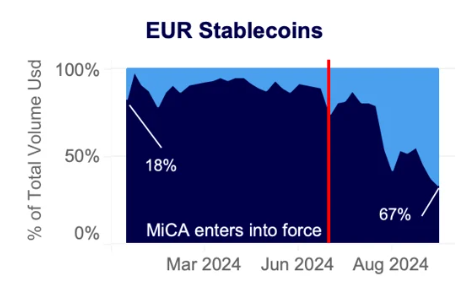In order to cover the European Union market, Tether has made an investment in Quantoz Payments, a firm that is launching two new stablecoins in the region: EURQ backed in euros, and USDQ backed in dollars.
These are two stable currencies that already comply with the regulations of the Regulation for the Cryptoactive Market (MiCA) that will come into force next January. so that They already have registration as electronic money tokens (EMT), as reported by Tether in a statement this November 18th.
“EURQ and USDQ aim to offer faster, cheaper and more transparent financial transactions compared to current traditional European payment systems,” explains Tether. He adds that his objective is to facilitate Seamless digital transfers in euros and dollars in European markets.
The new stable coins will be broadcast in Hadron, an asset tokenization platform that Tether launched this November 14. Both will be available for trading on Bitfinex and Kraken, starting Thursday, November 21.
The idea is that a series of compliance tools can also be managed from this platform: know your customer (KYC), anti-money laundering (AML), know your transaction, risk management and monitoring of the secondary market ecosystem.
In this way, “Tether is redefining the digital economy and opening doors to greater economic opportunities and broader financial inclusion,” the letter adds, indicating that the team has received several expressions of interest. from different institutions and companies in Europe to use Hadron by Tether.
“Our support for Quantoz highlights Tether’s commitment to promoting regulated solutions within the digital asset landscape,” said Paolo Ardoino, CEO of Tether, who did not clarify whether these stablecoins correspond to the new solution for the European market which he had announced last October.
New stablecoins enter a reconfiguring market
As reported by CriptoNoticias, the CEO of Tether reported that the company would soon launch a new asset that will adapt to the regulation of the European Union and that could replace USDT in the region. This, after having announced that the most popular stablecoin on the market Binance/” target=”_blank” rel=”noreferrer noopener”>could not comply with the new regulation.
Ardonino explained the reasons on the eve of the entry into force of MiCA rules for stablecoins, citing among them the strong restrictions established around the way reserves are managed, forcing cash deposits in at least six banking entities.


Operations with euro stablecoins have been falling since the entry into force of MiCA for stablecoins. Source: Kaiko.
Ardoino’s statements led to a string of announcements from Cryptocurrency exchanges that reported USDT withdrawal (and stablecoins that do not comply with MiCA) from their lists.
It is thus expected that, if it does not comply with the requirements of the new legislation before the end of the transition period, USDT will leave regulated platforms of the European Union. This is planned for this month of December.
Meanwhile, Europe’s stablecoin market is in full reconfiguration. The most recent data from the Kaiko firm points to a 70% drop in operations with euro stablecoins. A context in which greater growth is expected for the Circle USDC stablecoin and in which Tether now plans to compete with the two new stablecoins.
Crypto Keynote USA
For the Latest Crypto News, Follow ©KeynoteUSA on Twitter Or Google News.






